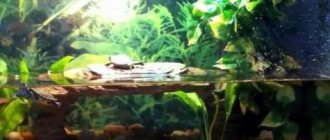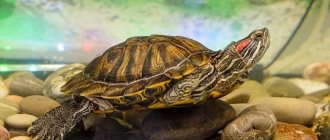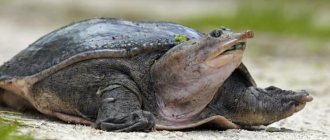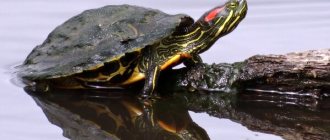Why should a turtle have a cozy home?
Today there is a lot of controversy among reptile lovers about this. Some argue that unlimited space throughout the apartment allows the turtle to independently choose a comfortable place for itself.
And others categorically condemn such content, explaining this by the negative impact of floor dirt on the health and life expectancy of the animal.
Did you know? Turtles have gone down in history as the most ancient reptiles. Evidence of this is found in the remains that are more than 220 million years old. Modern scientists suggest that prehistoric reptiles were distinguished by their enormous size, thick lower layer of shell and teeth. In diameter, such an animal reached about 3.5 meters.
Experts consider it unacceptable for a heat-loving reptile to wander freely around the human monastery for several reasons:
- such walks are fraught with injury to the turtle;
- the absence of a terrarium will greatly affect her health, since without a personal abode she will not be able to receive enough moisture and light;
- Walking around the apartment, the reptile will look for a secluded corner. As a rule, in such hard-to-reach shelters there is a lot of dust and a high probability of drafts;
- If you don’t arrange a corner for your pet according to his preferences and requirements, he won’t be able to dig the soil. And this habit is inherent in the turtle by nature;
- To keep such fauna representatives indoors, it is important to provide them with solid objects. In nature, they love to chew shells and chalk, and in an apartment they will look for anything that gets in their way. It is possible that among this there will be things dangerous to the pet’s health or valuable to the owners.
If we weigh all the pros and cons of freely keeping land turtles, the conclusion arises about the need to build a comfortable terrarium in which the ward will be happy in his own way.
Did you know? Archelon is considered the largest prehistoric turtle. The skeleton belonging to him, which archaeologists discovered, reached a diameter of more than 4 meters. It is estimated that the weight of this animal was 2.2 tons.
Design options
Terrariums can have different designs, each of which has its own special qualities.
Wooden structure
Most often, at home, these pets are kept in ordinary wooden boxes of appropriate sizes. This is a simple design that is easy to build and does not require special materials.
In addition, such items can always be found in a barn, garage or storage room. If you can’t find a suitable container anywhere at home, you can buy it inexpensively ready-made.
Wood and glass combination
Many breeders improve wooden structures by replacing one of the walls with frosted plexiglass. It is important not to forget about the ventilation holes.
You will be interested to learn about the features of keeping a land turtle, snapping turtle, Central Asian land turtle, fringed turtle, swamp turtle, Chinese turtle, snapping turtle, red-eared turtle.
In such variations, the floor is made of thin plastic or linoleum or laminate, and the roof has an upward opening or retractable lid.
Plastic container
This is an inexpensive, but very comfortable house for the ward. Its main disadvantage is the difficulty of installing a lamp to heat a turtle. It is important that this item does not threaten her life and provides the necessary amount of heat and light.
An alternative is to use commercial plastic rodent cages.
Did you know? All turtles are long-lived. In natural conditions they can live for more than a hundred years. For example, the oldest armored reptile in Europe is still considered to be a ward of the Galapagos Zoo named Harrient, who died in 2006. Then the animal turned 250 years old. But the most interesting thing is that on his life’s path he had the opportunity to meet Charles Darwin himself, who brought him to the European expanses
.
Floor pen
According to experts, this is not the best option for keeping a turtle. But at first, until the question of her permanent place of residence is resolved, you can fence off a corner for the ward right on the floor in the apartment.
The height of this fence should correspond to the size of the resident (we will talk about this in more detail later). It is important that the floor is insulated, otherwise the reptile will get sick and die. It cannot be kept on bare tiles.
It is advisable to cover the equipped pen with a piece of linoleum or a rubber mat. Remember that land animals do not respond well to open areas. The temperature in the room with the pen should not fall below +25 degrees.
Aquarium
Turtles adapt well to being kept indoors in a regular aquarium for aquatic fauna. They can provide an area for lamp heating, as well as ventilation holes. The disadvantage of this option is the high cost of the design.
Shelf in the sideboard
Not a bad option for an armored ward, but its arrangement requires a lot of effort on the part of the owner. It is important to ensure good mounting of the heating lamp, and this design must also be safe. Give preference to wide and high shelves so that the beast does not get burned.
Important! A turtle terrarium must have small pebbles. If the animal shows a tendency to swallow pebbles, immediately replace the mound with larger stones.
Setting up a terrarium for a land turtle
Remember that a land turtle at home does not live exactly the same as in the wild. In the wild, the reptile has the opportunity to travel wherever it wants, but in your home its personal space will be limited. You should know that it is not recommended to let turtles roam around the house - the animal can simply get sick if it gets into a cold room. Also, your pet will be able to climb into a secluded place where there is a high risk that he will get stuck. In the end, you will be able to step on your pet without noticing it. Based on this, you need to understand that a terrarium for a land turtle should be spacious and not restrict the reptile’s movements. The ideal size of a home for your pet is a few square meters. Of course, everything will depend on the size of the turtle itself. Make sure your pet feels comfortable in the terrarium you choose.
The parameters of the terrarium depend primarily on the number of turtles and their size. The volume of the terrarium should be 2-6 times the size of the animal itself. If the dwelling is intended for one small turtle (6-15 cm), maintaining the boundaries of 60*50*50 will be sufficient. A terrarium for a large turtle or two small ones should not be less than 120 (100)*50*50. The formulas correspond to the following indicators: length*width*height.
Appearance of the terrarium
The terrarium looks like a wide square or rectangular box closed on all sides with a small height and special ventilation holes.
Material for making a terrarium
The materials most often used for a terrarium are non-toxic plastic, wood, plexiglass and, sometimes, ordinary glass. The transparent material is usually left for the opening side. If the turtle does not notice the glass and fights against it, it is better to apply a terrarium background.
The most convenient at home is a terrarium, the front wall of which slides apart (the glass slides out of the grooves). Or the glass can be attached with magnets. The minimum height of the side of the terrarium is 10-20 cm. This is enough so that the turtle cannot get out on its own. When choosing a height, it is also taken into account that a layer of soil will need to be poured.
Read also: Dry red wine for pregnant women
It is a mistake to assume that reptiles only need daylight. This is absolutely not true. If you want to create a truly comfortable environment for your pet, purchase an ordinary lamp and install it so that it illuminates the entire terrarium. In addition, a terrarium for a turtle requires the presence of an ultraviolet lamp, which is necessary for the proper development of the pet’s body. It is enough to turn on the UV lamp for just a few hours a day.
The internal arrangement of a terrarium for land turtles requires special equipment and instruments. The dwelling must be equipped with a heating lamp (this can be an incandescent lamp of 40-60 W), an ultraviolet lamp for reptiles, a feeder, a house and a thermometer. For tropical species of turtles, you need to add a bathing suit and a hydrometer to this list.
Climate and ventilation in the terrarium
Ventilation holes can be located anywhere: below, above or on the sides. The home should not be heated from below; the temperature at different ends of the terrarium should be different. In the warm zone, the optimal temperature is 30 degrees, and in the cool zone - 25-28. To achieve these conditions, an incandescent lamp is used as a heater. A swimming pool is placed next to it, that is, in a warm zone, and a house is placed on the opposite side.
Soil for a terrarium
Many reptile owners use dry hay as substrate. However, this option can be harmful to the pet - the use of dry plant branches is fraught with injury to the pet. In fact, there are a lot of types of soil, and anything can be used as soil for reptiles. However, the most correct solution would be to create a multi-layered soil that has both hard areas on which the turtle will grind its claws, and islands where the animal can burrow.
The ideal soil for your pet will look like this:
- At the very bottom there is an absorbent film. It will absorb the waste products of the reptile, preventing it from polluting the terrarium;
- It is recommended to place an ordinary bath mat with holes in the middle. Excess moisture will pass through them, which will then be absorbed into the film. It is worth noting that a terrarium for a turtle often becomes a place for its games - the animal can simply bury itself under the rug. To avoid this, you need to provide for its fixation at the edges;
- There is soil at the top. As mentioned earlier, there are two types of filler you can use. The ideal soil is gravel and sand. It is advisable to divide the terrarium into two parts, one of which will be intended for burying the pet, and the other for walking it.
After creating the soil, be sure to check for sharp stones or other foreign objects. Remember that sometimes the soil needs to be replaced to prevent contamination of the terrarium.
Food place. What can't you do?
It is advisable to teach your pet to eat from a special bowl. Your tortoise's terrarium can be a great feeding area if you add a shallow bowl. This is where the food should be placed. Make sure that the reptile does not have any difficulties when feeding - the edges of the dishes should not be high.
Many turtle owners make the unacceptable mistake of placing a container of water in the terrarium. It will not only be unnecessary for the pet, but can also create certain problems for it. A terrarium for a land turtle does not require the presence of water - reptiles drink when they bathe. By installing a drinking bowl, you will only increase the air humidity, which can adversely affect your pet.
Also, some breeders recommend planting cereal seeds, which are beneficial for the reptile’s body, in a certain place in the terrarium. However, this option will be appropriate if your turtle is not a very active digger.
Subsequently, based on your pet’s behavior, you will understand what bothers him and what he likes. Gradually your terrarium for a land turtle
will change, and as a result you will create completely comfortable conditions for the reptile.
Selection of materials for construction
Most often, terrariums for land turtles are made of natural wood, non-toxic plastic and glass.
Each of these materials has its own advantages and disadvantages:
- For example, plastic products are very light . This material is easy to work with, it is accessible, inexpensive and easy to maintain.
- One of the sides of the abode is usually made of glass - the one through which you will feed your reptile. For this purpose, ordinary or organic glass is used. It is worth considering that in most cases turtles do not notice a transparent barrier, which is why they hit their shell against it. Therefore, experts advise not to expose the animal to injury and to decorate the glass walls with a natural terrarium background.
- Wooden structures are inferior in their heaviness , but deserve attention for their practicality and endurance. Many breeders combine these materials, taking into account the comfort of the pet and the external decorative effect of the structure.
- Most often, turtles are kept in square or rectangular houses made of wood and glass . Variations are practical, where the glass covers can not only be moved aside, but even removed from the grooves. In some structures they are simply attached with magnets.
Important! Proper housing for a land turtle includes a varied diet, weekly swims in warm water and summer walking outside (no more than 1 hour a day)
.
DIY bridges for turtles
Many people have probably seen bridges for turtles in stores. These are environmentally friendly and safe products that are usually held on the walls of the aquarium using suction cups.
You can make such bridges for turtles with your own hands. The main condition for this is not to use untreated tree branches or driftwood. The fact is that pet stores sell bridges treated with a special impregnation that prevents wood from rotting. If you put an ordinary branch into an aquarium, the water in it will soon deteriorate and can even harm the health of the turtle, just like improper feeding of turtles.
DIY houses for land turtles
One turtle measuring 6 to 15 cm requires at least 0.5 m² of living space. As a terrarium for a turtle, you can use a low, long, wide and closed box with holes for ventilation.
The box can be made of wood, non-toxic impact-resistant plastic, glass or plexiglass. It should be borne in mind that these animals love privacy, so when choosing a glass house for them, only one wall should be left transparent. In addition, turtles often do not see transparent glass walls and can hit their shells against the glass, trying to pass through it.
Read also: Life expectancy with emphysema
However, most often turtles are kept in glass aquariums equipped with a shelter-house. Half of a clay flower pot, cut vertically, or half of a coconut would be perfect for such a house. You can make houses for land turtles with your own hands, or you can purchase them in specialized stores.
DIY plywood house
To work you will need:
- 4 identical plywood rectangles for the walls of the future house.
- One square piece of plywood for the roof.
- Glue for working with wood.
- Tools for woodworking.
- In two wall parts, wide arches should be cut into which the turtle will fit freely. If your animal is still small, it is recommended that when cutting out the entrance holes, make them the size of an adult animal. Otherwise, after a few months you will have to increase the size of the arches.
- Then the wall parts are connected using glue, and the roof of the house is glued on top. After treating with glue, the new home should dry and weather well.
- After about two days, you can move a new tenant into it.
Straw basket house
To arrange such a house you will need a rectangular basket, which can be purchased at any interior design store. Lay the basket on its side and make a bedding. Install heating and ultraviolet lamps above the house.
It is necessary to ensure that there is no draft in the terrarium and that the air temperature is maintained within 22˚C. Turtles are very sensitive to cold and can get pneumonia.
Have you made an island, a bridge, a house for your turtle? From what materials? Tell us about it in the comments.
How to set up a terrarium for land turtles
If you are wondering how to set up a terrarium for a land turtle, then you will soon become the owner of this wonderful pet. First of all, remember that reptiles, just like people, need comfort. Based on this, you can begin to arrange a terrarium, following the rules for keeping turtles in captivity.
Tools and materials required for work
The most practical and inexpensive design is made of plywood and plexiglass.
It will also be useful for you to find out why a turtle does not open its swollen eyes, how long a turtle lives at home and in the wild, what turtles eat, why and how to inject Eleovit into turtles.
In order to build a homemade terrarium for your pet, you will need:
- saw or jigsaw;
- a sheet of plywood from which 4 parts will need to be cut, measuring at least 90 x 50 cm (can be replaced with plastic);
- glue gun or screws for fastening parts;
- thin wooden strips for securing the walls;
- corners for side walls;
- 2 slats with grooves for glass;
- drill;
- silicone glue;
- plastic covers to cover ventilation holes;
- lamp for heating the animal (it is advisable to provide a special protective lampshade for it);
- feeders;
- drinking bowls;
- a piece of linoleum on the floor;
- special bedding (soil);
- swimsuit;
- hygrometer;
- thermometer.
Do-it-yourself islands for turtles
Aquatic turtles, despite the fact that their main habitat is water, need an island of land in their living space. If you do not provide the animal with a place where it can get out of the water and rest, the turtle will simply drown. In addition, it needs dry land to prevent certain shell diseases.
Read also: Discharge of yellow sputum when coughing
Video on how to make an island for turtles with your own hands
When starting to care for a turtle at home, some owners of these reptiles make islands for turtles with their own hands, while others buy everything they need at a pet store. If you decide to equip a terrarium yourself, then you should take into account that the optimal size of the land area should be such that about three turtles of the same size as yours can easily fit on it. If there are several of them in the terrarium, then the island should be made so that the animals do not feel cramped on it. In addition, it is necessary to take into account the fact that turtles often fight among themselves for territory, so it is best to equip two or more islands.
Basic requirements for islands for aquatic turtles
- Structural strength, stability and safety.
- It must be convenient for the turtle to climb onto the island, so it must be equipped with a ladder.
- Rough surface of the island and the ladder to it so that the turtle does not slip.
- Absolutely dry surface.
- Environmentally friendly materials.
- The walls of the aquarium must be at least 20 cm higher than the level of the island, otherwise the animal will escape from its home.
- The island must be heated with heating and ultraviolet lamps.
- The ladder should not be placed too close to the bottom, as the animal may get stuck between the ladder and the bottom and drown.
Made from pieces of glass with processed edges. On the surface of the glass you need to stick smooth pebbles, a special grass covering or a piece of soft polypropylene runner for the bathroom. Do-it-yourself islands for young red-eared turtles are best made “for growth,” since these penny-sized babies quickly turn into adults the size of a large man’s palm.
The island is glued to a dry and clean aquarium wall using aquarium sealant. When the turtle's housing is ready, it is necessary to leave it for several days until the glue has completely dried and weathered, and only then move the animal in.
Islands of stones
To equip the island, you can stack large stones. To make the structure strong and safe, the stones are first glued together with glue-sealant, well weathered and dried, and then placed in the aquarium.
Also, a large, stable stone is perfect for arranging an island.
Tile island
To make such an island, you need to choose tiles with a rough surface. To secure the ladder, you can drill two or three holes in it, or simply glue it with special glue.
Necessary requirements and dimensions
If turtles lead a silent lifestyle, do not think that they will be happy with any conditions that you provide them. Please note that by bringing such a ward into your home, you will be dealing with a very demanding reptile.
Do-it-yourself aquarium-terrarium for a turtle: video
Important! It is strictly forbidden to feed the turtle with piece food for cats and dogs. It is also detrimentally affected by keeping it in a small terrarium, the lack of special soil and regular walking.
The first thing you need to pay attention to is the size of the structure. Experienced breeders advise calculating the required area, guided by the following rule: the length, height and width of the structure should be increased from the dimensions of the reptile by 2 - 6 times.
That is, if the diameter of a turtle is 10 centimeters, then the parameters of its abode should reach half a meter. This also applies to the height of the terrarium, which is also measured taking into account the length of the animal. In cramped conditions, this value can be multiplied by 2.
If you plan to keep several pets, then you will have to calculate the area for them for each one separately. For a couple of ten centimeter household members, you need a cubic structure with sides of about a meter. Remember: the more space, the more comfortable your pets will be.
The material for a turtle's home must be selected based on its size and the endurance of the ward. That is, small structures for heat-loving animals can be built from wood, while plastic is suitable for cold-loving animals.
Also consider the possibility of thermal insulation of the walls using polystyrene foam. Ideally, turtles that like the cold should be kept in separate rooms from those that prefer a lot of heat.
If this is not possible, you will have to build a special terrarium stand, placing more hardy living creatures in the lower tiers.
Did you know? Sea turtles have a unique feature that is rightfully considered a record among all spinal animals. They tend to hold their breath for more than 10 hours.
Each turtle breeder should bring the home conditions of his charges as close as possible to natural ones. Only then are they guaranteed good health and longevity.
DIY terrarium for a land turtle
Everyone can save on the purchase of comfortable and durable housing for an armored household. After all, the construction of a terrarium does not require special knowledge and skills. Veterinarians advise that for the psycho-emotional comfort of the turtle, three walls should be made of wood or non-toxic plastic, and one wall should be made of organic glass.
In the terrarium you can also keep a chameleon, tree frog, salamander, aquarium toad, tarantula spider, African snails, monitor lizard, centipede, gecko, royal python, newt, crocodile, iguana, butterflies, African hedgehog, sand boa, corn snake.
Terrarium for a land turtle: video
How to make a terrarium from a closet
A ready-made bookshelf with glass sliding doors or a furniture wall is perfect for this:
- Choose a durable and wide shelf that will fit the size of your ward. Do not forget to take into account the safe height of this structure in conditions of lamp heating.
- If the factory design does not provide a separate door, you need to use a tape measure to measure its dimensions and cut them out of glass yourself with a glass cutter.
- These parts are attached to special plastic grooves or glue.
- It is important to provide ventilation and a lid to open the structure.
- For the comfort of the animal, its back wall should be covered with a natural background characteristic of the natural environment of turtles.
- Also, among the details of the terrarium, it is necessary to provide a separate shelter for the pet. This can be an ordinary flower pot or a wooden structure that can accommodate a reptile. Some breeders make two-story buildings, where there is a house below and a heating area at the top.
- At the end of construction, install a heat lamp. It should provide enough light and warmth, but not harm the animal or your property.
- Cover the floor in the turtle's house with hay or sawdust, and lay out small pebbles in the rest of the area.
- Place feeding and drinking utensils away from the lamp.
Did you know? Turtles can go hungry for a long time. For example, the elephant species goes without food for 18 months. Considering these features of reptiles, ancient sailors took them on voyages as long-term canned food.
.
A terrarium from a cabinet is very simple to build, but its significant drawback is the complexity of arranging lamp heating. Often, incorrect placement of this device leads to injury to the animal and damage to the construction material.
How to convert an aquarium into a terrarium
Since turtles love water treatments, having their own pool in the terrarium will not hurt them. Please note that the type of water depends on the variety of your ward.
Experts advise to provide in advance that each resident of the turtle house has at least 100 liters of volume. The height of the home should not be lower than 40 centimeters. This is necessary so that the pet has the ability to freely maneuver and swim in any direction.
The content of such a structure has many requirements. The water in the aquarium should be changed every 5 days, but it is strictly forbidden to renew the entire volume. Only a third needs to be replaced in order to maintain the microbalance of the aquatic environment.
Did you know? Many people mistakenly consider turtles to be the slowest creatures on the planet. In fact, they are very agile in water, in which they can reach speeds of up to 35 kilometers per hour. On land, their mobility decreases to 15 km/h. It has been noted that the colder the air temperature, the slower the land reptile will crawl.
To convert an aquarium into a full-fledged terrarium, you should adhere to this technology:
- Choose a glass vessel that fully complies with the recommendations described above.
- Wash the aquarium thoroughly, removing possible dirt and mold (this applies to containers that have already been in use);
- Cover 3 walls of the container with a photon that corresponds to the pet’s natural habitat.
- Using a jigsaw, cut a sheet from plywood or plastic that will fit in the container and cover one third of its length.
- Glue (or attach with screws) 4 slats to the cut out part, which will act as supports. Their length should only rise a few centimeters above the water level.
- Glue together a side for a piece of land from round pebbles and, in the same way, build a spherical structure to shelter the reptile. It is important that on land there is space left for her to warm herself under the lamp.
- Using wooden planks, the length of which is slightly less than the width of the aquarium, use glue to build a ladder so that the animal can descend along it into the water.
- Place about 3 centimeters of sand and pebbles on the bottom of the aquarium. You don't have to plant algae because turtles eat it.
- Install the lamp above the structure so that the light is not located directly above the person's food.
- Place hay bedding in the shelter.
Important! When walking your turtle outside, do not allow it to eat poisonous or medicinal plants. Contact with other pets is also contraindicated.
.
Plastic terrarium for turtle
If you prefer to build an abode for your pet from plastic, first decide on the required dimensions of the structure and prepare the necessary material.
This solution is good because if mistakes are made during the assembly process, the frame can be easily disassembled using ordinary strong thread. It is carried out in places where parts were fixed with silicone glue.
Execution sequence:
- Using a jigsaw, cut out 5 sheets for the walls and bottom. We calculate their sizes according to the above recommendations.
- We lay the bottom and apply silicone glue to the joints of the side and rear walls.
- Place the back wall on the bottom and fix it until the glue hardens. If the material does not fit well, you can use purchased corners for plastic products. You can purchase them at any hardware store.
- We assemble all the other walls in the same way. For better adhesion of the glue, experts advise spraying the connected parts with water from a spray bottle.
- When the structure is dry, use a blade to remove excess glue from the parts and cover all seams with sealant so that spilled water does not destroy the material.
- Decorate the walls with a natural background, familiar to a turtle.
- Set up a home for your pet inside. Its standard attributes are: covered (you can take a flower box of the appropriate size and make an entrance in it or a piece of a hollow wooden block), pebbles, hay bedding, sand, a food bowl and a drinking bowl.
- Place a lamp over the area where the sand is scattered.
- Cover the structure with a glass sheet of appropriate size on top. It will help keep you warm inside and allow you to keep an eye on your ward.
Important! It is not recommended to use thermal cords and thermal mats to heat terrariums. 60 W incandescent lamps are most suitable for this purpose. They are placed in the corner, thus dividing the terrarium into warm and cold zones. In the first option, the air temperature should reach 28-32 degrees day and night, and in the second - 22-24 degrees
.
How to make a wooden terrarium
This option is convenient due to its wide space for the client and the possibility of comfortable installation of lamps. In such a design, it is easy to build a wide, high shelf so that the animal can climb up a ladder for better heating.
Also, for convenience, you can provide a second house there. If desired, a swimming pool can be attached at the bottom of the structure. It all depends on your imagination, capabilities and preferences of the pet.
Technology for building a basic box:
- Cut a base measuring 90x50 cm from a plywood sheet.
- Using a glue gun, attach the strips around the perimeter of this part to which the walls will be attached.
- We fix the side walls to the corners with screws. Thus, at this stage of construction we have a bottom with 2 side walls and 1 back.
- Cover the bottom with another sheet of plywood. This is necessary so that the slats do not create discomfort for the client, and the floor is level.
- Using a glue gun (screws), we attach a strip with grooves for glass on the front side of the floor.
- On the side we make one ventilation hole with a diameter of 3 mm. They are no longer needed, since in this case the animal will be exposed to drafts. If you decide to use a mesh made of perforated aluminum sheet as ventilation, then its size depends on the location. For example, the top ventilation should be a third of the width of the structure, and the bottom should be made in the form of a pocket 20 - 50 mm wide.
- We cut out a valve of the appropriate size from plastic and lightly cover the ventilation, preventing insects and dust from entering inside.
- Treat all wooden parts twice with hot drying oil, then coat with furniture varnish. This treatment will protect the structure from dampness.
- We install the lamp. For incandescent appliances, a lampshade must be provided. It is important that this item is not placed too low above the surface where the turtle will be crawling. If the air in her house warms up to more than +25 degrees, then she is in danger of overheating.
- Decorate the terrarium with bedding, pebbles, shells, and arrange a feeding and watering area. Cover the floor with sawdust or hay.
Important! When using glass parts in the manufacture of homemade turtle terrariums, experts recommend giving preference to material 4-5 mm thick.
Interior of a terrarium for a land turtle
The soil is poured in a layer of 3-4 centimeters; small substrates, sand, and gravel chips are not suitable for land turtles - the animal can swallow them and clog its stomach. The use of expanded clay, sharp gravel, and shavings is not allowed. The best option is large sawdust, coconut coir, rounded pebbles, hay, and for non-burrowing turtles – decorative rugs. If this is a quarantine terrarium, napkins or paper are used as soil. You cannot keep turtles without soil.
The so-called sandwich is also interesting - soil made of several layers, it can be removed once every 2 weeks. An absorbent film is placed at the bottom, a rubber bath mat is placed on it, and gravel or coarse sand is placed on top. The terrarium should also have shelter - it could be half a coconut, a hollow piece of driftwood, a clay flower pot or a wooden house. It is best to place the shelter in the cool part of the terrarium.
The feeder is installed under a lamp, it should be heavy so that the animal does not turn it over, with low edges, and easy to wash. The bath can also be installed in a warm corner: the water level should reach the middle of the turtle’s shell. The water is changed daily, in addition, it is advisable to bathe the turtle once a week, since it absorbs moisture through the skin.
Plants should be non-poisonous, since a turtle can taste them; decorative decorations should not have sharp corners or protrusions.
The terrarium needs to be disinfected regularly (the turtle is removed during this time). It is washed, ventilated, the drinkers and feeders are thoroughly washed, the soil and plants are disinfected. With proper care, turtles live for decades, delighting their owners.
There are two types of pet turtles: land and aquatic. When arranging a home for your pet, you need to take into account all the points regarding the care and maintenance of these reptiles, although the turtle is considered a rather unpretentious pet.
Where to put a terrarium for a turtle
The correct location of the terrarium is equally important. It should not be placed in drafts or direct sunlight. This is a common mistake made by beginners who think that this way they can provide the reptile with enough light and warmth.
But in such conditions, with intense solar heating, the vents cannot cope with the high temperature. If the structure is made of glass, the thermometer in it may show 400 degrees. As a result, the animal finds itself in a hellish trap with no chance of survival.
Experts advise placing the structure in the northern part of the house, where it is always dark: it should not be an attic or attic room. It is best to prefer a basement or basement rooms with excellent heat and moisture insulation. In a small room, the corner behind a blind door would be ideal for a terrarium.
Did you know? Today, as a result of active fishing, turtles are on the verge of extinction. Every third armored reptile dies due to its use by people in cooking or folk medicine.
How to set up a terrarium for land turtles
We have already partially touched on this topic, but since it is in this area that breeders often make gross mistakes that lead to the death of animals, we will dwell in detail on every detail in the turtle house.
A special place for this kind of wards is given to the ground. It must be used regardless of the material from which the terrarium will be made. Without special coating, land reptiles suffer from deformed paws and abraded claws. To prevent this from happening, pour regular river sand or sawdust into the tank .
Many breeders who have been dealing with turtles for years advise keeping the pet’s living conditions as close as possible to its natural environment. Therefore, preference should be given to pebbles and sand .
Ideally, it is advisable to initially cover the floor of the structure with a bathroom rug (it will absorb excess moisture), and make a mound of soil on top. Use both materials in one design. The animal will burrow in the sand and sharpen its claws on the pebbles.
Did you know? The smallest turtles today are considered to be the inhabitants of South Africa - Cape speckled turtles. Their body length barely reaches 10 centimeters and weighs 140 grams.
The next important element in the terrarium is the heating device. It is cheaper to use conventional lamps up to 60 W, but UV devices have also proven themselves to be effective. Their advantage is to replace sunlight and heat, which these heat-loving reptiles so lack.
It is important to take into account that such objects should be located above the animal’s shell at a distance of 20-30 centimeters. At night, appliances can be turned off. But the best option would be to install an automatic relay, which will make it easier to control the lighting mode.
In the area where the lamp shines, it is advisable to place bowls for water and food for the ward, and in the cold area there should be his shelter house. To do this, you can use a regular wooden (plastic) box with an entrance and ventilation.
The feeder should have no sharp corners so that the pet does not get injured. In addition, it needs to be dug into the ground so that the food does not turn over. It is preferable to choose ceramic products for such purposes. The same requirements apply to drinking bowls.
Did you know? Of all the representatives of this genus of fauna, snapping turtles are considered the most aggressive and dangerous. They attack snakes and waterfowl. There have been cases when these reptiles have chewed off the fingers of divers. Note that they do not have teeth, but they have a powerful beak that can even bite off a piece of wood.
To control the temperature in the terrarium, experts advise equipping it with thermometers in the areas where the lamp works and where the shelter is located.
Turtles love moist air, so if their abode does not have an aquarium, periodically spray the room with cold water from a spray bottle.











